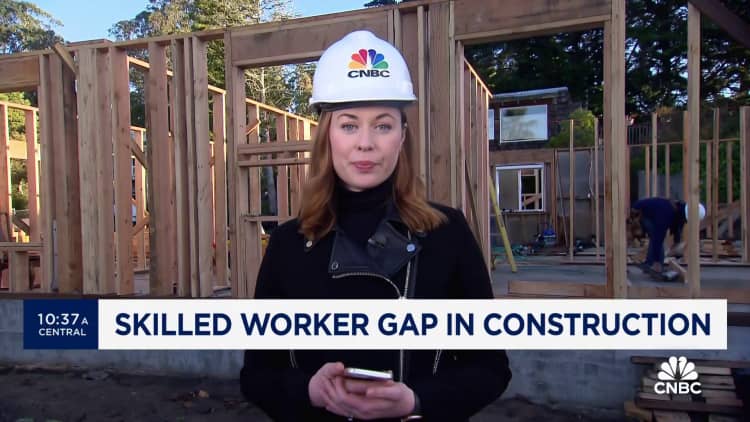Construction workers erect a building in downtown Miami, Florida, on June 14, 2023.
Jim Watson | AFP | fake images
At Ample's Bay Area manufacturing facility, employees work on the floor alongside robots, making battery packs and other parts for its battery-swapping technology for electric vehicles.
The work is clean, high-tech and skilled – all key hiring points as the company looks to grow its ranks in the coming year. It hopes to double its manufacturing workforce to 100 people by the end of the year.
Finding people who have the training to do those jobs can be a challenge.
Ample is working with brands from Daimler to stellantis to Uber to replace dead electric vehicle batteries with fully charged ones and get electric cars back on the road quickly. He expects business to get a boost as the United States works toward its renewable energy goals.
Ample is facing a problem that has plagued many manufacturers for years: a shortage of skilled workers. The company is looking for workers with experience to operate high-voltage machinery and complex robotics. It is also fill less qualified positions.
“I think the important thing for us to understand is that as machines become more sophisticated, manufacturing becomes more automated,” Ample CEO Khaled Hassounah told CNBC. “That means we expect a lot more from the people who manage the process, from the people who actually do the manufacturing, and that naturally means the work becomes a lot more sophisticated.”
The company is taking matters into its own hands. Ample is pursuing learning partnerships with City College of San Francisco, Laney College and the College of San Mateo, launched as a result of the Inflation Reduction Act.
These training programs give the company confidence that it can achieve its growth objectives. He said some of the positions Ample is hiring for do not require a college degree.
“We're realizing that we can lean on community colleges to provide that. You don't have to go to college for two years just to get started. But there are classes that you will take that will really fundamentally increase your ability to work. “Really good , or even do it safely, or be able to be more effective,” Hassounah said.
As hiring ramps up, Ample is bucking the slowdown in manufacturing jobs in the United States and around the world. The sector added just 12,000 net jobs in 2023 for various reasons, including auto worker strikes last fall, according to the Bureau of Labor Statistics.
The United States added 23,000 manufacturing jobs in January, but there were 601,000 unfilled positions in the industry in December, a three-month high, according to data from the Bureau of Labor Statistics. This year is expected to be challenging for the sector as the economic outlook is uncertain and companies struggle to recruit suitable staff in a tighter labor market, according to an industry outlook from consultancy Deloitte.
Companies that rely on blue-collar workers in their trades face challenges finding the right job candidates as Baby Boomers retire and younger ones choose between college and the workforce. The Manufacturing Institute, an industry advocate, projected in 2021 that about 4 million manufacturing jobs will need to be filled by 2030, and more than 2 million jobs could remain unfilled in the sector by then if workers are not engaged in modern manufacturing. careers.
“The biggest misperception about manufacturing is what modern manufacturing is really like; people just don't know,” said Carolyn Lee, president of the Manufacturing Institute. “They think it's old-fashioned or that you come in and do a job. They don't know that modern manufacturing today is all about technology.”
The group is expanding its recruiting efforts among workers of all demographics, backgrounds and ages, and is even beginning to educate high school children about opportunities in the industry.
The construction industry also faces shortages
More manufacturing jobs are likely in the coming years as funding from the CHIPS Act, the Inflation Reduction Act, and the bipartisan infrastructure deal arrive. But growth will go beyond that.
Construction hiring has also increased, as the sector added an average of 16,000 jobs per month in 2023. Manufacturing-related construction jobs have also grown over the past year. Industry observers expect more to come.
“It's hundreds of billions of dollars over the next four or five years,” Ben Brubeck, vice president of state, labor and regulatory affairs at the trade group Associated Builders and Contractors, said of federal funds tied to construction and manufacturing projects. “And that's going to have a big impact on the skilled labor and the shortages that we're facing right now.”
It is estimated that the construction industry will need to hire an additional 501,000 workers on top of the normal hiring pace in 2024 to meet labor demand, according to a proprietary model developed by the trade group.

Smaller employers are likely feeling the trades hiring crisis more significantly. The National Federation of Independent Business reported that job quality was among the top three concerns for small business owners in December, just behind inflation.
Thirty-three percent of all small business owners surveyed had openings for skilled labor, and the group cited hiring challenges as most acute in the construction and transportation sectors.
To ease hiring problems, companies aim in part to hire younger workers and train them for jobs in manufacturing and construction. It's something even high schools are doing in unique ways.
At South San Francisco High School, a course that was designed as a traditional carpentry elective has been transformed into a two-year trades course for the construction industry.
“Actually, going from building a birdhouse to learning how to form walls and roofs on buildings was just understanding, what are students going to need to be competitive in the work environment?” said Jason Brockmeyer, director of innovation, community outreach and special projects for the South San Francisco High School District. “And what can we do to help them get there? We really focus on trying to ensure not only that students are prepared for college, but also for their career.”









